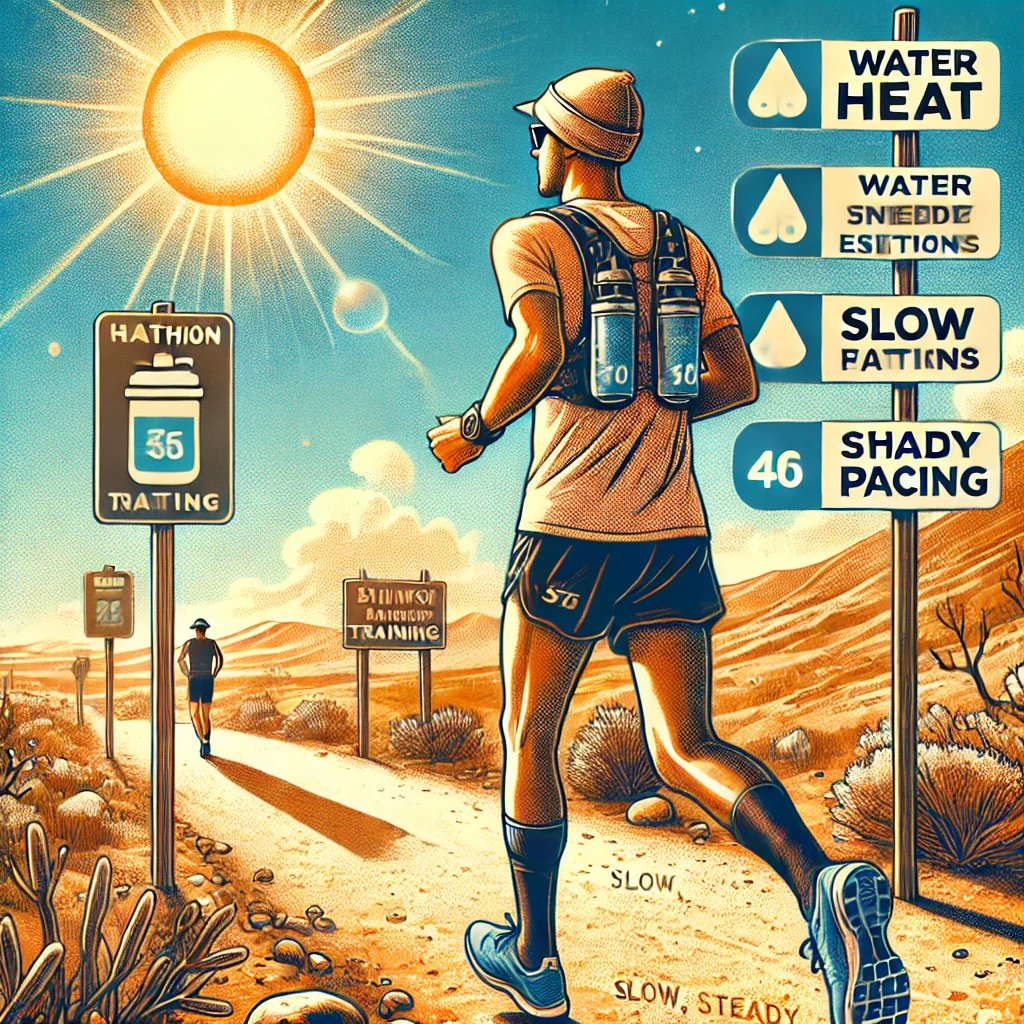Running a marathon is a challenging feat in itself, but doing so in a hot climate adds an extra layer of difficulty. High temperatures can sap energy, increase the risk of dehydration, and make it harder for the body to regulate heat. Building endurance in these conditions requires a specialized approach, focusing on adapting the body to the heat and maintaining optimal hydration. For runners aiming to succeed in hot-weather marathons, understanding how to prepare effectively is key. This involves adapting training routines, making smart choices about hydration and nutrition, and using the right gear to combat the heat. With the right strategies, runners can develop the resilience and stamina needed to thrive, even when the temperature rises.
Understanding the Challenges of Running in Hot Climates
Running in hot climates presents unique challenges that can impact performance and overall health. The body’s natural response to heat is to cool itself through sweating, but in high temperatures and humidity, this process becomes less effective, leading to an increased risk of dehydration and overheating. Understanding these challenges is crucial for marathon runners looking to build endurance in hot conditions.
Dehydration and Its Impact on Performance
One of the primary concerns for marathon runners in hot climates is dehydration. As temperatures rise, the body sweats more to maintain a stable core temperature. This leads to a rapid loss of fluids and electrolytes, which are essential for muscle function and energy. Dehydration can cause a decrease in blood volume, making it harder for the heart to pump oxygen-rich blood to the muscles. As a result, runners may experience early fatigue, muscle cramps, and a significant drop in performance. Without proper hydration strategies, dehydration can quickly become a major obstacle during training and races.
Heat Exhaustion and Heatstroke Risks
Another challenge of running in hot climates is the risk of heat-related illnesses, such as heat exhaustion and heatstroke. Heat exhaustion occurs when the body becomes overwhelmed by high temperatures and is unable to cool down effectively. Symptoms include dizziness, nausea, and excessive sweating. If not managed properly, heat exhaustion can progress to heatstroke, a life-threatening condition where the body’s temperature rises above 104°F (40°C). Runners in hot climates must be vigilant about recognizing early signs of heat-related stress and adjusting their intensity or stopping to cool down when necessary.
Adjusting to Elevated Temperatures and Humidity
Acclimatization is a critical factor for runners who plan to compete in hot climates. The body needs time to adapt to the increased temperatures and humidity levels to function efficiently during exercise. Acclimatization involves gradually exposing oneself to the heat over a period of weeks, allowing the body to improve its ability to sweat, maintain fluid balance, and reduce the heart rate during exertion. Runners who take the time to acclimate properly can enhance their heat tolerance, making it easier to sustain long-distance efforts without succumbing to the negative effects of the heat.
Understanding these challenges allows runners to approach their training with the knowledge and strategies needed to minimize risks and improve their endurance in hot climates.
Effective Training Techniques for Building Endurance in Heat
Building endurance for marathon running in hot climates requires targeted training techniques that help the body adapt to high temperatures and improve overall stamina. Here are some of the most effective methods for preparing to run in the heat:
- Gradual Heat Acclimatization
The best way to prepare for running in hot climates is to gradually increase exposure to high temperatures over a period of two to three weeks. Start by incorporating short runs during the warmer parts of the day and slowly extend the duration. This allows the body to adjust to the heat, improving its ability to sweat efficiently and maintain core temperature. As the body becomes more accustomed to the heat, runners can safely increase the intensity and length of their training sessions. - Incorporating Tempo and Interval Training
Tempo runs and interval training are essential for building speed and endurance, even in hot conditions. During these sessions, runners work at a pace slightly below their race pace, pushing their cardiovascular limits while managing heat stress. Interval training, where high-intensity efforts are alternated with rest or lower-intensity recovery periods, helps the body adapt to varying levels of effort, making it better prepared for the demands of a marathon. - Using Early Morning or Evening Runs
To minimize the risk of overheating, many runners choose to train during the cooler parts of the day, such as early mornings or late evenings. These times of day offer lower temperatures and less direct sunlight, reducing the strain on the body while still allowing for effective training. While heat adaptation is important, cooler sessions can help maintain consistent training volume without excessive risk. - Strengthening Core Muscles for Better Stability
A strong core is vital for maintaining good running form, especially when fatigue sets in during long runs. In hot climates, runners tend to experience greater muscle fatigue due to increased energy expenditure in the heat. Core-strengthening exercises like planks, Russian twists, and leg raises help runners maintain stability and efficiency during their stride, even in challenging conditions. - Including Cross-Training Activities for Balanced Fitness
Cross-training activities like swimming, cycling, and yoga can complement running sessions by enhancing cardiovascular endurance and flexibility without adding to the heat stress on the body. Swimming, in particular, offers a way to build aerobic capacity while keeping cool. Incorporating cross-training into a weekly routine can help prevent overuse injuries and keep the body in top shape for marathon training.
By implementing these training techniques, runners can effectively build the endurance needed to handle the challenges of marathon running in hot climates, ensuring that their body is prepared for the rigors of race day.
Importance of Hydration and Nutrition
Proper hydration and nutrition are essential for marathon runners training in hot climates, as they directly impact performance and recovery. In extreme heat, maintaining the right balance of fluids and nutrients becomes even more critical, helping runners stay hydrated, energized, and resilient against the effects of high temperatures.
Best Hydration Practices for Hot-Weather Running
Staying hydrated is the foundation of running safely in hot conditions. Runners should drink water consistently throughout the day, not just during their runs. Pre-run hydration is particularly important, with athletes encouraged to consume around 500 ml of water or an electrolyte-rich drink about two hours before starting their run. During longer training sessions, carrying a hydration pack or planning routes with access to water stops can help maintain fluid levels. Drinking small sips regularly rather than large amounts at once can prevent gastrointestinal discomfort.
Electrolyte Balance and Recovery Drinks
In addition to water, maintaining electrolyte balance is crucial in hot-weather running. As runners sweat more, they lose vital minerals like sodium, potassium, and magnesium, which are essential for muscle function and nerve signaling. Including electrolyte tablets or drinks in the hydration routine helps replace these lost minerals and prevents cramps or muscle fatigue. After a run, recovery drinks that contain both carbohydrates and electrolytes can help replenish energy stores and restore hydration levels, aiding in faster recovery.
Pre-Run and Post-Run Nutrition Tips for Hot Conditions
The right nutrition before and after a run is key to maintaining energy levels and aiding recovery. Before a run, consuming easily digestible carbohydrates, such as a banana or a slice of toast with peanut butter, can provide the necessary fuel without causing digestive issues. Post-run meals should include a balance of proteins, carbohydrates, and healthy fats to repair muscles and restore glycogen levels. For hot-weather training, including water-rich fruits like watermelon, oranges, and cucumbers can provide both hydration and vital nutrients.
By focusing on hydration and nutrition, runners can better withstand the challenges of training in hot climates, ensuring that their bodies remain fueled and ready for the demands of a marathon.
Gear and Clothing for Hot-Weather Marathon Training
Choosing the right gear and clothing is crucial for runners training in hot climates, as it can significantly impact comfort, performance, and safety.
- Lightweight and Moisture-Wicking Clothing: Opt for clothing made from moisture-wicking fabrics that draw sweat away from the body, keeping runners dry and cool. Lightweight materials such as polyester blends or specially designed athletic fabrics help improve airflow and prevent overheating.
- Choosing the Right Footwear for Heat and Humidity: In hot climates, it’s important to select running shoes that offer good breathability and ventilation. Shoes with mesh uppers allow better air circulation, reducing the risk of blisters and discomfort caused by excessive sweating. Insoles with moisture-wicking properties can also help keep feet dry.
- Using Cooling Accessories (Hats, Towels, etc.): Accessories like wide-brimmed hats or visors can provide shade for the face and neck, reducing sun exposure. Cooling towels soaked in cold water and wrapped around the neck during breaks can help lower body temperature during training runs.
- Importance of Sunscreen and Skin Protection: Applying a high-SPF, sweat-resistant sunscreen is essential to protect the skin from UV rays, especially during long runs in direct sunlight. Sunglasses with UV protection are also recommended to prevent eye strain and protect against harmful rays.
The right gear ensures that runners remain comfortable and protected while training in hot climates, allowing them to focus on building their endurance and performing at their best.
Mental Strategies for Endurance and Motivation in Hot Conditions
Endurance running in hot climates is as much a mental challenge as it is a physical one. Staying motivated and focused when the heat is draining can make a significant difference in training effectiveness and race-day performance.
Visualization and Positive Mindset
Visualization techniques can help runners mentally prepare for the challenges of hot-weather training. By imagining themselves successfully completing their runs despite the heat, athletes can build mental resilience and maintain a positive outlook. A positive mindset, where runners focus on their progress and the end goal rather than the discomfort, can help push through tough training sessions.
Breaking Down Long Runs into Manageable Segments
For marathon runners, breaking down long runs into smaller, manageable segments can make the task feel less overwhelming. This mental strategy allows runners to focus on reaching short-term milestones, such as the next hydration break, rather than thinking about the entire distance. This approach can prevent mental fatigue and keep motivation high throughout the run.
Setting Realistic Goals and Celebrating Small Wins
In hot climates, runners may not achieve the same pace as they would in cooler conditions, and it’s important to set realistic goals that take the heat into account. Celebrating small wins, such as completing a run without stopping or hitting a hydration goal, helps maintain morale and keeps runners motivated over time.
By adopting these mental strategies, runners can better manage the psychological challenges of training in hot climates, helping them stay committed and resilient as they build the endurance needed for marathon success.
Description:
“Learn how to build endurance for marathon running ☀️ in hot climates with expert tips on hydration, training, and heat adaptation.” (150 символов)



